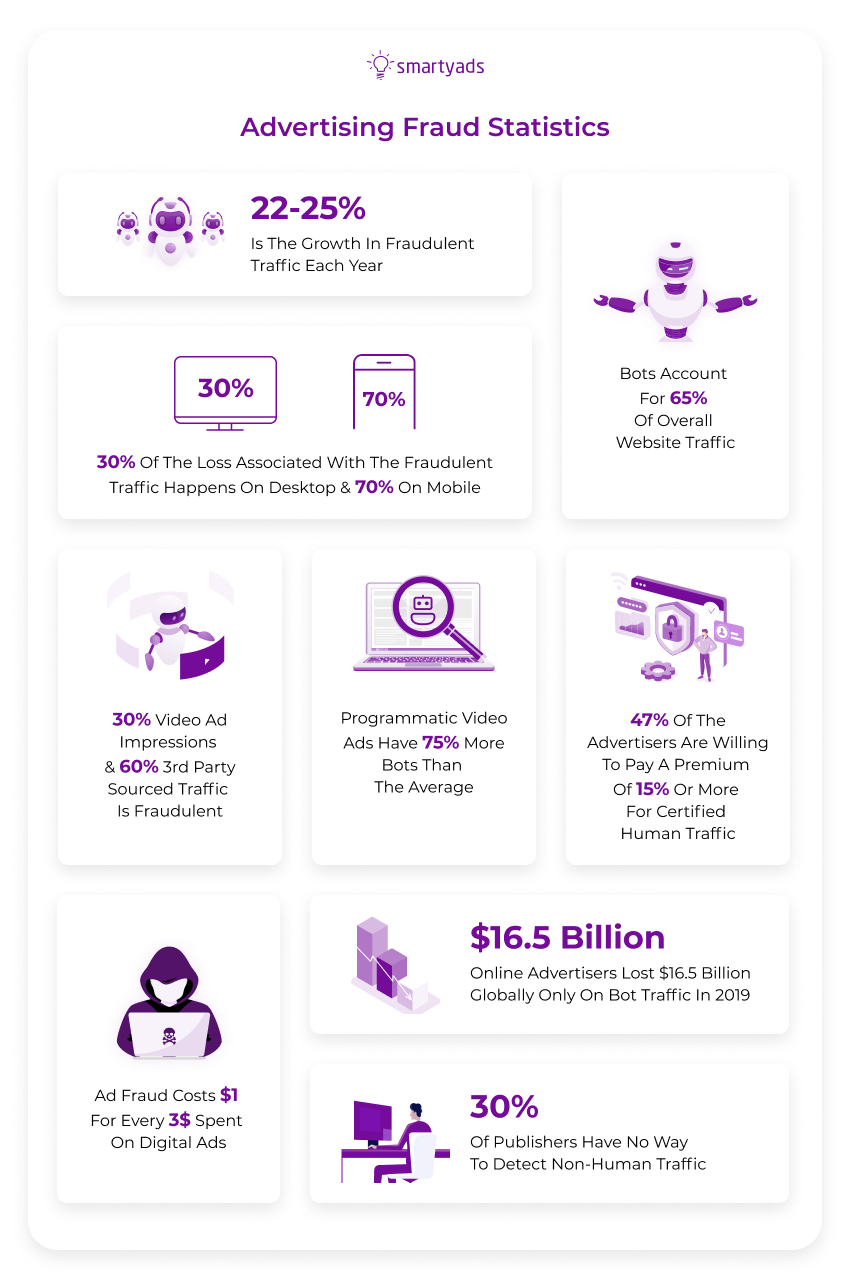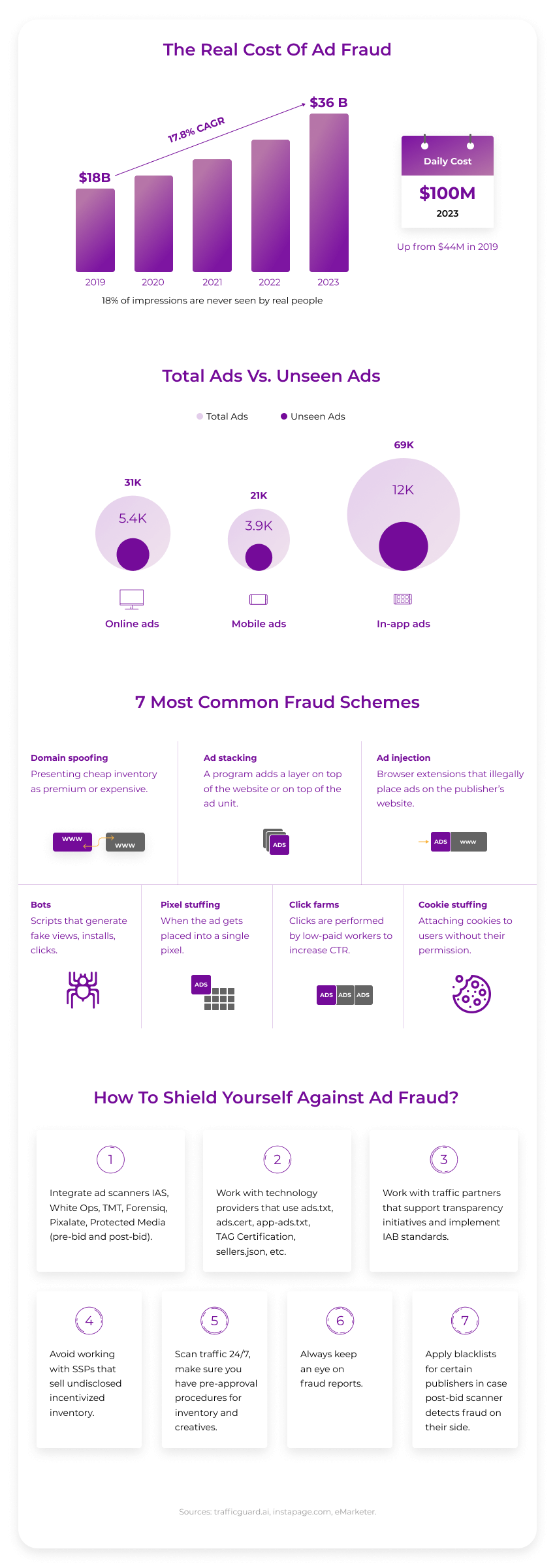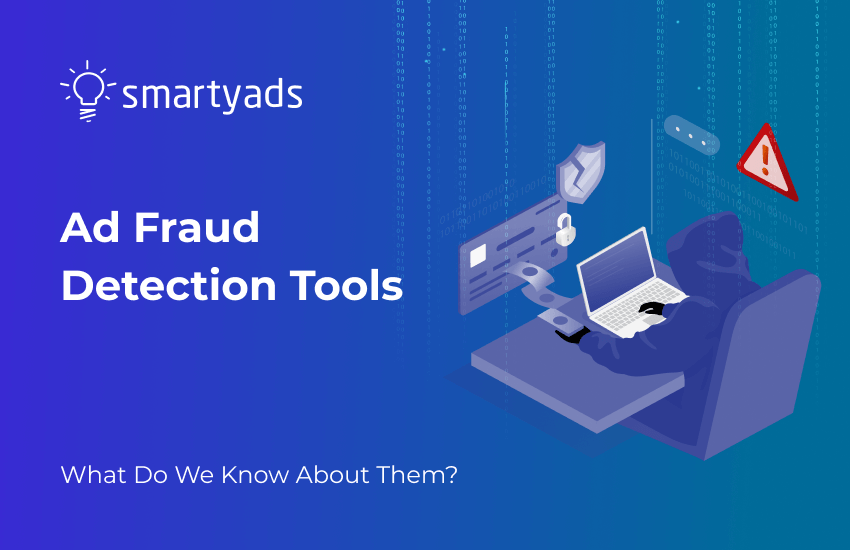Advertising fraud detection companies closely collaborate with ad tech businesses, and this trend is not new. When investing their money in ad campaigns, advertisers and media buyers hope that they will receive only human and viewable impressions without any injections of bot traffic.
Theoretically, advertising should be shown only to the target users. In reality, everything is slightly different, and some of the impressions that advertisers track in their marketing analytics systems can be generated by bots or malicious programs.
Such problems need real-time solutions, such as detection techniques and scanners designed to fix them and prevent them from happening on both the supply and demand sides. Let’s explore the landscape of modern ad fraud prevention tools to understand how they work, how to integrate them, and what is the difference between post-bid and pre-bid scanning.

What is ad fraud?
Ad fraud refers to traffic that drains an advertiser's budget without delivering any value. Normally, ads attract users who are genuinely interested in the content. However, with fraudulent traffic, the clicks, views, or downloads are generated by bots or users incentivized to perform specific actions.
As a result, the advertiser’s target audience doesn’t see ad impressions, and advertisers don’t reach their desired goals—brand awareness or conversions. Still, the resource that serves the ads generated by bots gets paid as if the generated clicks or views were human.
The cost of ad fraud tactics for the industry
To start off with, desktop and mobile ad fraud techniques can be different, but the main idea behind them is to generate fake clicks, impressions, or any sort of conversion.
Global digital advertising fraud costs are projected to rise significantly between 2023 and 2028, increasing from $88 billion to $172 billion. This represents an approximate annual growth rate of 14%, nearly doubling over the five-year span.

Common types of ad fraud
Some SSPs aggregate traffic from individual publishers and ad networks to maximize web traffic volumes. In such circumstances, it becomes difficult to monitor all web traffic partners, let alone individual publishers, each of which gets paid per action performed on their business site.
There’s always a chance that some players will try to overcome rules by resorting to the following types of digital ad fraud:
Domain spoofing
In this situation, the URL of the site where the ad is served gets misplaced. The ad server receives false info about where the ad runs. Indeed, the impression takes place at cheaper inventory. Also, fraudsters can create an exact copy or mirror of an existing legitimate website.
Cookie stuffing
This fraudulent practice is common in affiliate marketing, where cookies are filled with incorrect user data. Cookie stuffing results in fraudsters earning undeserved affiliate commissions while advertisers lose revenue and receive distorted performance data.
Bots
This most common type of adtech fraud uses Internet scripts to generate all kinds of bot traffic, clicks, fake video views, and impressions. A bot or person generates numerous clicks on an ad, quickly depleting the advertiser's budget.
Pixel stuffing
When the ad is placed in a single pixel, it becomes invisible to users but is still recorded as a view. This deceptive tactic artificially inflates impression counts, leading advertisers to pay for ads that no one can actually see.
Ad stacking
A program uses a multi-layered approach and adds a layer on top of the website or the ad unit. While only the top ad is visible to users, impressions are registered for all the ads in the stack.
Click farms (device farms)
Fake clicks are performed by low-paid workers using many different devices to increase CTR. Different platforms specifically pay online workers to perform such kinds of ‘assignments’ to simulate user interactions with ads.
Ad injection
Browser extensions that illegally place ads on the publisher’s website without publishers knowing. These ads often disrupt the user experience, redirect traffic to unauthorized destinations, and divert revenue away from publishers.
Fraudulent CTV space
Scammers frequently fabricate fake CTV devices or use device emulation software to produce fraudulent ad impressions, giving the illusion that real users are viewing the ads.
Synthetic ID’s
Fraudsters employ AI-generated identities to replicate real users, including realistic browsing patterns and behavior. These fake profiles can engage with ads, complete lead forms, or perform actions that replicate real humans.
AI-powered schemes
By 2025, AI-driven schemes will use deepfakes and advanced algorithms to mimic real user behavior, generating fraudulent clicks that closely resemble genuine interactions.

How can you prevent advertising fraud?
In 2024-2025, DSPs and SSPs learned how to filter out suspicious or invalid traffic before the bid even takes place – all thanks to the introduction of detection technologies like Forensiq, Pixalate, TMT, IAS, and so on.
Thus, clients can now trust their programmatic budgets to platforms with early fraud detection systems that were developed only a few years ago. Additionally, cybersecurity professionals recommend adhering to the following advertising fraud detection and protection practices.
Work with trusted vendors
Work with technology providers that use ads.txt, ads.cert, app-ads.txt, TAG Certification, sellers.json, and other traffic and seller verification standards (SmartyAds has them in place). Make sure your vendor has pre-approval procedures for inventory and creatives.
Choose platforms adhering to IAB practices
Work with SSPs that are ready to support transparency initiatives and implement IAB standards for their publishers. Additionally, avoid working with SSPs that sell undisclosed incentivized inventory.
Employ scanners
Use the DoubleClick bid manager to scan your system for non-human traffic with scanners that work 24/7. Alternatively, choose a platform that has them integrated. If there’s an opportunity, keep an eye on fraud reports and generate them every week or every day to ensure that traffic in your marketplace is 100% valid.
Use filters
Apply blacklists for certain publishers in case the post-bid scanner detects fraud on their side. Leverage whitelists to filter preferred resources and black lists on DSP to exclude certain resources.
Mobile ad fraud
For effective mobile ad fraud protection, it is important to know some of the most common tactics that fraudsters use on this medium.
Common mobile schemes
- Ads pseudo-attribution. In this scheme, bad guys—the resource owners—place several ads on top of one another. The visitor on the site sees only the top ad. If vendors pay per impression, the attackers will be rewarded for showing all the ads.
- Click fraud. The main purpose of this one is to imitate the actions of real users in order to trick marketing analytics tools into believing that fraudulent clicks and traffic are real. It can be performed with device farms (it uses many real devices to create non-human traffic).
- Click injection is one type of mobile ad fraud in which malware is embedded on the device to track apps downloaded to it. Once the installation is complete, the malware manages to click on the app before the user launches it.
- Click-bombing (spamming). Using this scheme, the scammers bombard the app with clicks in order to capture attribution, i.e. they click (launch) it before the users do it themselves. Each click is assigned a unique identifier that corresponds to the device ID of the real user who downloaded the advertised app.
- Device ID reset. This scheme involves a cycle of endless app installs and resetting the device ID on which it is downloaded. For the advertiser, this would mean that its product was downloaded each time by unique, organic users. How it works: the scammer clicks on the ad, downloads the advertised app, installs it, performs some more actions in it, and then resets the device ID to do the same thing again.
- App ID spoofing. Fraudsters use this cheating scheme: They run an ad in the fraudulent app, but the advertiser thinks it's showing in another app that was claimed when it was placed. Attackers simply change the parameters and provide fake or stolen identifiers.
- SDK spoofing is a mobile scheme that involves bots and malware. An app embedded in another—the real one—generates clicks, plays other actions in it, and sends it to the MMP (mobile measurement partner). This malicious scheme is very difficult to detect. Any application that uses the SDK is vulnerable to SDK spoofing.

Features and characteristics of the modern ad fraud detection tool
What makes a decent ad fraud detection technology? A good tool can significantly reduce threats by automatically banning suspicious impressions and bots at the bidding stage or prior. Such tools can be installed on both supply and demand sides.
Pre-bid scanners
They identify threats before the ad is served at the request stage. Such scanning tools monitor and sort out requests before bidding, which is why their cost can be slightly higher. However, scanners filter out invalid traffic before it is counted as an impression, which makes such ad fraud detection tools the most reliable.
The post-bid scanners
They give advertisers, agencies, and marketers an opportunity to investigate where a fraud source is at the response stage. The tracking tags contained in creatives make it easy to understand which domains or creatives are fraudulent or compromise brand safety.
Such scanners work in real-time and detect pre-bid or post-bid suspicious activities; some tools can do both. However, this logic of fraudulent activity detection is intrinsic only to a certain type of scanners. Indeed, prevention techniques are highly diversified.
Ad fraud detection companies: types and principles of work
Ad fraud detection companies create a detection software or utilities, non-stop scanners, and whole software platforms to protect the advertising ecosystem from scammers. Let’s review the most popular of them.
Pixalate
Pixalate uses big data analysis, which was created by data scientists, to identify characteristic signs of online advertising fraud. Thanks to machine learning technologies, the scanner interprets new fraudulent methods and defines particularly sophisticated schemes by applying the scanning techniques we discussed above. Their technologies work across display, in-app, video, and OTT/CTV environments.
Pixalate is a supply scanner supported by SmartyAds Solutions. It uses image pixels and all types of macroses for traffic scanning (which platform owners can select for themselves).
Pros: Pixalate uses big data and machine learning for effective detection across multiple environments, including OTT/CTV. (pre- and post-bid scanning). May not support all traffic channels.
Cons: May not support all traffic channels.
Protected Media
Scanner from Protected Media is also based on smart artificial intelligence and machine learning technologies for fraud detection scanning. It prevents fraud from happening before the impression takes place, and post-bid gives insights into specific ad fraud sources. The scanner works for Connected TV, Display, and Video advertising.
Pros: AI-driven scanner prevents fraud before impressions occur, it also provides valuable post-bid insights into fraudulent sources, covering a wide range of ad environments.
Cons: The system may require specific integration and setup.
Forensiq scanner
The Forensiq scanner is designed to mitigate affiliate fraud, traffic fraud, and abnormalities. It assesses every impression according to the proprietary fraud score metric and evaluates the potential viewability and brand safety score of the traffic source.
The solution provides a full-funnel invalid traffic detection (SIVT & GIVT accredited) across various traffic channels and effectively protects inventory from bad actors.
Pros: A full-funnel invalid traffic detection and protection against affiliate and traffic fraud.
Cons: It may not be as effective for detecting fraud in non-standard traffic sources or ad formats.
TMT Scanner
TMT scanner is a solution that focuses on ad fraud prevention on both the demand and supply sides. It offers fraud prevention, media filters for integration, malware attack data, creative and website quality assurance, customer hack prevention, and digital insights on fraud occurrence. TMT closely collaborates with IAB and the world’s largest media owners.
The TMT scanner can also function in your SmartyAds Solutions, but you need to negotiate it prior to installation to turn it on for your system. After this, you will be able to turn it on and set up the daily scan limits (see the screen above).
Pros: Works with major media owners, providing holistic protection across demand and supply sides.
Cons: Requires prior negotiation for integration into the system.
IAS Integral Ad Science
The IAS scanners (which stand for Integral Ad Science) are also among the best ad fraud detection companies for advertisers and publishers.
This company provides ad fraud solutions that are accredited by MRC for SIVT (Sophisticated Invalid Traffic) detection. IAS allows the delivery of verified inventory. The three stages of traffic verification they use are ad network scanning, behavioral pattern detection on real devices, and malware checks that will work across all traffic channels.
Pros: IAS is MRC-accredited for SIVT detection and provides verified inventory across all traffic channels.
Cons: May be less effective with emerging or unconventional ad formats and requires significant integration time.
White Ops
White Ops is a cybersecurity company; its solutions protect publishers and advertisers from the majority of threats associated with ad fraud. White Ops is one of the largest fraud detection companies that’s been in charge of protecting the traffic of Oath Adobe and other big ad tech industry players since 2012.
White Ops solutions are MRC accredited and can be used by advertisers and publishers who want to eliminate invalid inventory across environments (desktop and mobile ad fraud detection) and verticals (especially in travel, retail, and financial ones).
Pros: Has a proven track record in protecting major industry players, providing comprehensive fraud prevention across multiple verticals.
Cons: May be more suited for larger advertisers and publishers, making it less accessible for smaller companies.
Why your SmartyAds Solutions are brand-safe and secure
We want to remind our clients that we collaborate with the world’s best ad fraud detection companies and regularly partner up with new ones to outsmart even the most sophisticated fraudulent schemes. We want to keep our publishers and advertisers as safe as possible.
Our advanced cybersecurity scanners focus on ad fraud prevention and detection. Moreover, we offer API key implementation so that you can integrate any scanner of your choice and keep your traffic safe and secure.
If you need individual implementation of any scanner, please be sure to notify us.
The last word
Ad fraud detection tools will not cease to develop as long as advertising space is plagued with bot traffic, ad click fraud, and fake views. Taking into account the fact that programmatic programming actively expands to new environments, e.g., OTT/CTV or audio, in the future, the variety of ad fraud schemes will only grow.
The sooner ad tech providers (and also publishers and advertisers) realize the real state of things, the better trading environment they will be able to create for their direct advertisers and publishers, and the higher incomes of money they will be able to generate in the end.
Drive only real human traffic and quality impressions that translate into conversions -- choose SmartyAds Solutions.





![In-App Advertising: the Complete Guide [Updated 2025]](/storage/uploads/2020/september/in-app-advertising-trends.png)